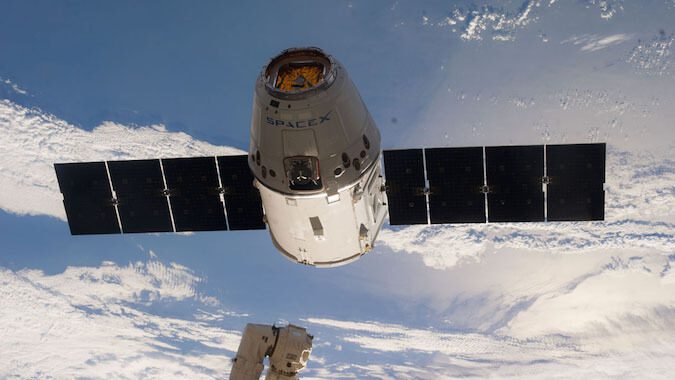The Dragon CRS-14 cargo craft was launched by a Falcon 9v1.2FT Block 4 on its way on a NASA funded delivery mission to the International Space Station. The launch took place at 2030 GMT on 2 April 2018 from the rocket’s Cape Canaveral launch site in Florida. After its approach, the ISS robotic arm captured the spacecraft at 1040 GMT on 4 April.
Also aboard the flight was the 120kg RemoveDebris mission of the University of Surrey/SSTL which will be launched released from the ISS to debris capturfe technologies (harpoon/net etc). Two small 2kg target payloads Debrisat 1 and 2 are also included to simulate debris. The mission is part funded by the EU.
In addition a cubesat class payload called Overview 1 is also being delivered to the ISS for its release from there. It will use a 4K camera to provide high resolution 360 degree video of Earth to provide a virtual reality experience of space to subscribers.
The launch used a reused first stage equipped with landing legs which had been previously used in August 2017 for the Dragon CRS-12 launch. However, with SpaceX’s decision to move to the more robust Block 5 reusable first stage for later flights, there was no need to recover the reusable stage (Block 4’s are only economically viable for a single reuse anyway) and it was splashed down into the Atlantic after some experimental manoeuvres were carried out to test the trajectory envelope.
The Dragon CRS-14 capsule had itself been reused from an earlier mission Dragon CRS-08 in April/May 2016.

Dragon CRS-14 approaches ISS ready to be grappled by the ISS robot arm. Courtesy: NASA
Also aboard the Dragon – well inside its trunk – were the Atmosphere-Space Interactions Monitor, the Materials ISS Experiment Flight Facility and a pump and Flow Control system which will all be fitted to the ISS.
Equipment carried inside the pressurised part of the spacecraft were some high definition cameras for astronaut use, and a printer.







